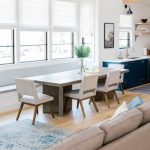Are you wondering how to decorate homes in a way that reflects your personal style and creates a welcoming space for you and your family? Understanding the fundamentals of home decoration is the key to achieving a space that is both functional and aesthetically pleasing. From choosing the right colors to arranging furniture for optimal flow, every aspect plays a role in creating the perfect atmosphere for your home.
When it comes to home decoration, it’s essential to grasp the basics of color, lighting, and space. These fundamental elements form the foundation of any well-designed interior. By understanding how these components work together, you can create a harmonious environment that sets the stage for a beautiful home.
In addition to the basics of home decoration, finding your style is crucial in making your space feel like home. Whether you lean towards modern, traditional, bohemian, or minimalist design, identifying your personal preferences will guide you in selecting decor that resonates with your individual taste. This section will delve into different home decor styles and provide insight on how to determine which one best suits your lifestyle and aesthetic vision.
Finding Your Style
When it comes to home decoration, one of the most important aspects is identifying your personal style and preferences. Your home should be a reflection of your personality and taste, so taking the time to explore different decor styles can help you determine what resonates with you the most.
There are various home decor styles to choose from, including modern, traditional, bohemian, minimalist, industrial, and more. Each style has its own attributes and characteristics that can help create a specific atmosphere within your home.
Exploring Different Home Decor Styles
To find your personal home decor style, it’s essential to familiarize yourself with the different options available. Modern style often features clean lines, minimalistic furniture, and a focus on open spaces. On the other hand, traditional decor tends to include classic furniture pieces, rich colors, and elegant designs.
Bohemian style embraces a free-spirited and eclectic approach, incorporating vibrant colors, patterns, and global influences. Minimalist decor focuses on simplicity and functionality with an emphasis on clean surfaces and neutral tones. By understanding these various styles and their defining elements, you can begin to identify which one resonates with your individual preferences.
Determining Your Ideal Style
As you delve into the world of home decor styles, take note of elements that appeal to you the most. Whether it’s the sleek look of modern design or the cozy textures of bohemian decor, pay attention to what captures your attention. Consider factors such as color schemes, furniture choices, patterns, and overall aesthetic when determining which style best suits your personal taste.
Additionally, think about how you want your space to feel – whether you prefer a relaxed and casual atmosphere or a more formal and structured environment. This self-reflection will play a crucial role in identifying your ideal home decor style.
By understanding the various home decor styles available and determining which one aligns with your personal preferences, you can begin to curate a living space that truly feels like home. Whether you’re drawn to the clean lines of modern design or the warmth of traditional decor, finding your style is an essential step in creating a personalized and comfortable environment within your home.
Creating a Color Palette
When it comes to home decoration, one crucial aspect to consider is the color palette. The colors used in a home can greatly impact the overall atmosphere and mood of the space. Choosing the right colors can make a significant difference in how a room looks and feels.
Coordinating Colors
One important factor to consider when creating a color palette for your home is coordinating colors. This involves selecting colors that complement each other and create a harmonious look throughout the space. Whether it’s choosing a wall color that coordinates with the furniture or selecting accent pieces that tie into the overall color scheme, coordination is key in achieving a cohesive and visually appealing result.
Color Psychology and Trends
Understanding color psychology can also be beneficial when choosing colors for your home. Different colors can evoke different emotions and moods, so it’s important to consider how you want each room to feel. Additionally, staying updated on current color trends can provide inspiration for choosing modern and stylish color palettes that suit your personal taste.
Personalizing Your Color Palette
Ultimately, selecting a color palette for your home is a highly personal decision. It should reflect your individual style and preferences. Some people may prefer vibrant and bold colors, while others may lean towards more subtle tones. Personalizing your color palette ensures that you feel comfortable and happy in your space, making it truly feel like home.
Furniture Arrangement
When it comes to arranging furniture in your home, it’s important to consider both space and functionality. Whether you’re working with a small apartment or a spacious house, strategic placement of furniture can make a significant impact on the overall flow and usability of your space. To maximize space and ensure optimal functionality, it’s essential to carefully plan the layout of your furnishings.
One important consideration when arranging furniture is to create designated areas for different activities. For example, in a living room, you’ll want to arrange seating in a way that facilitates conversation and also allows for easy access to other areas of the room. Similarly, in a bedroom, positioning the bed in the right spot can create a sense of balance and harmony while leaving enough space for other necessary elements such as dressers and nightstands.
Another key aspect of furniture arrangement is considering traffic flow. It’s important to ensure that there are clear pathways throughout the room to avoid creating obstacles or bottlenecks. This is especially crucial in smaller spaces where every inch counts. By arranging furniture strategically, you can create an open and inviting atmosphere that allows for easy movement from one area to another.
In addition to maximizing space and ensuring functionality, furniture arrangement also plays a crucial role in enhancing the aesthetic appeal of your home. Thoughtfully arranged furniture can create visual interest and harmony within a space, contributing to an overall cohesive look. By considering both form and function, you can achieve a well-balanced arrangement that not only looks great but also serves its intended purpose effectively.
| Aspect | Description |
|---|---|
| Designated Areas | Create specific zones for different activities within each room. |
| Traffic Flow | Ensure clear pathways throughout the room for easy movement. |
| Aesthetic Appeal | Create visual interest and harmony through thoughtful arrangement. |
Adding Decorative Accents
When decorating a home, it is essential to pay attention to the details and decorative accents that can truly enhance the overall look and feel of a space. Accessories play a significant role in adding personality, warmth, and visual interest to different rooms within a home. By carefully selecting the right decorative accents, you can elevate your space and create a more inviting and cohesive atmosphere.
Here are some key decorative accents to consider when enhancing your home:
- Artwork: Incorporating artwork such as paintings, photographs, or sculptures can add visual interest and serve as focal points within a room.
- Plants: Adding greenery through houseplants or succulents can breathe life into a space and bring a touch of nature indoors.
- Rugs: Area rugs can define specific areas within a room, add texture, and tie the overall color scheme together.
- Throw Pillows and Blankets: These accessories can instantly add comfort, color, and personality to seating areas such as sofas, armchairs, or beds.
In addition to these decorative accents, it’s important to consider how lighting fixtures, mirrors, vases, and other accessories can contribute to the overall ambiance of your home. By carefully curating these elements, you can achieve a well-balanced and stylish look that reflects your unique taste and aesthetic preferences.
DIY Home Decor Projects
When it comes to home decoration, adding personal touches through do-it-yourself (DIY) projects can make a significant impact on the overall look and feel of your space. Here are some budget-friendly DIY home decor ideas to help you get creative and personalize your home:
- Repurpose old items: Upcycling old furniture or household items can add character and uniqueness to your space. Consider turning an old wooden ladder into a decorative shelf, or repainting and repurposing an unused dresser as a statement piece in your living room.
- Create custom artwork: Personalized artwork can add a special touch to your home decor. Get creative with canvas painting, photography, or mixed media art to showcase your own style and personality on the walls of your home.
- Handmade accessories: Adding handmade accessories such as throw pillows, curtains, or table runners can infuse warmth and individuality into your space. Look for DIY tutorials online or tap into your own creativity to craft one-of-a-kind pieces for your home.
By incorporating these DIY home decor projects into your interior design efforts, you can add a personal touch that reflects your unique style and personality throughout your living space. These budget-friendly ideas also allow for creativity while transforming your home into a place that truly feels like yours.
Incorporating Textures and Patterns
When it comes to decorating your home, incorporating textures and patterns into your design is a great way to add depth and visual interest to your space. Textures can range from smooth to rough, while patterns can be bold or subtle, all of which play an important role in the overall aesthetic of your home. By carefully considering and integrating various textures and patterns, you can create a dynamic and visually appealing environment that reflects your personal style.
One way to incorporate textures into your home decor is by using different materials such as wood, metal, glass, or fabric. These materials not only provide tactile sensations but also contribute to the visual richness of a space. For example, mixing smooth leather furniture with a plush rug or woven textiles can bring warmth and dimension to a room. Additionally, adding textured wall coverings or decorative panels can create an interesting focal point in any area of your home.
Similarly, patterns can be introduced through wallpaper, upholstery, rugs, curtains, or accent pieces like throw pillows. Whether you prefer geometric prints, floral motifs, stripes, or abstract designs, incorporating patterns into your decor adds personality and energy to the room. It’s important to balance the scale and intensity of patterns in order to avoid overwhelming the space but still infuse vibrancy into the overall design.
In addition to selecting specific materials and patterns for your home decor, it’s essential to consider how they work together cohesively. Mixing various textures and patterns requires careful planning and consideration of color schemes and furniture styles. By doing so effectively, you can achieve a harmonious look that brings character and visual interest into every corner of your home.
| Textures | Patterns |
|---|---|
| Wood | Geometric Prints |
| Metal | Floral Motifs |
| Glass | Stripes |
| Fabric | Abstract Designs |
Tips for Maintaining a Cohesive Look
In conclusion, decorating a home is a personal and creative process that involves understanding the fundamentals of design, identifying your preferred style, selecting the right colors, arranging furniture for optimal functionality, adding decorative accents, incorporating texture and patterns, and maintaining a cohesive look throughout the space. By implementing these tips and techniques, you can create a home that not only reflects your personal style but also feels harmonious and visually appealing.
One of the key aspects of maintaining a cohesive look in home decoration is paying attention to the overall color palette and ensuring that it flows seamlessly from room to room. By coordinating colors and considering color psychology, you can create a sense of unity throughout your home while still allowing for individuality within each space. Additionally, integrating different textures and patterns can add depth and visual interest to your decor while still maintaining a cohesive overall aesthetic.
Furthermore, it is important to remember that maintaining a cohesive look does not mean everything has to match perfectly. In fact, mixing different styles and elements can add character to your home. The key is to find a balance between varying design elements and ensuring they complement each other.
Ultimately, the goal is to create a space that feels unified and balanced while still expressing your unique personality and preferences. With these tips for tying it all together in mind, you can confidently approach the task of home decoration with creativity and intentionality.
Frequently Asked Questions
How Do I Start Decorating My House?
You can start decorating your house by first determining what style and theme you want to go for. Consider the overall look and feel you want to achieve, as well as any specific color schemes or patterns you prefer.
Once you have a vision in mind, begin by decluttering and cleaning the space to create a clean canvas for your decorations. Then, focus on adding elements like furniture, wall art, rugs, and decorative accents that align with your chosen style.
Which Is the Best Way to Decorate Your Home?
The best way to decorate your home is by incorporating your personal taste and preferences into the design. It’s essential to create a space that reflects your personality and brings you comfort and joy.
Consider mixing different textures, incorporating natural elements, playing with lighting, and adding pops of color to create visual interest. Also, don’t underestimate the power of organization and storage solutions to maintain a tidy and pleasing environment.
How Can I Make My House Look Attractive?
Making your house look attractive can be achieved through various strategies such as enhancing curb appeal with landscaping and exterior decor, creating inviting entryways with welcoming elements like plants or artwork, using mirrors to open up smaller spaces, investing in quality lighting fixtures to illuminate key areas, incorporating greenery for a touch of nature indoors, and utilizing decorative storage solutions to maintain tidiness without sacrificing style.
Ultimately, the goal is to create a harmonious living space that is visually appealing while also being functional and comfortable.

I’m thrilled to be your companion on this exciting journey through the world of home decor and design. With a passion for turning houses into homes and a keen eye for the finer details, I’m here to help you transform your living spaces into beautiful, functional, and meaningful havens.





